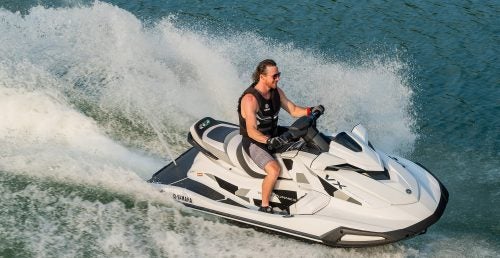PWC 101: Safety
Righting and re-boarding, accident prevention and noise control
PersonalWatercraft.com has teamed up with BoaterExam.com to give prospective personal watercraft enthusiasts the tools they need to get started.
This is the fourth article in a four-part series that we hope will teach potential PWC riders the basics about their craft and how to ride safely on the water.
Righting and Re-Boarding a PWC
It is relatively easy to right your PWC if it overturns. Most have a decal attached to the back of the vessel that indicates the proper direction to turn the PWC to the upright position. Consult your user’s manual if the decal is not present. Contrary to popular belief, there is a proper direction to turn it over, and you can do damage if you turn the PWC the wrong way.
While righting a PWC is a relatively easy task, re-boarding can be more challenging. It is especially difficult to re-board a PWC when you are tired or in rough waters. Practice re-boarding a few times in calmer waters before putting your re-boarding skills to the test on the open water.
Get the Flash Player to see this player. |
Accident Prevention
When it comes to accident prevention, common sense is your greatest ally. PWC ride low in the water and as a result they are difficult to spot and are often shielded from view by other boats. Here are a few key points that should keep you safe on the water:
* Keep your distance from other boats to avoid blind spots and to respect boaters’ space.
* Keep a safe distance from other PWC. Because the vessels can turn so quickly and accelerate rapidly, it is even more important to leave yourself enough time and space to react to other PWC operators.
* Take a look behind you before you make a turn, and please be mindful of your wake. A PWC can send a powerful stream of water from the nozzle that could distract, annoy or even harm other operators.
* Be careful that your spray does not affect other boaters, swimmers or cause injury to passengers who have fallen off a PWC during a quick acceleration.
Get the Flash Player to see this player. |
Noise Control
PWC, like most watercraft, can be noisy. There is no need to draw attention to yourself when operating your PWC in heavy traffic, close to the shoreline, or at the dock. Be aware of your surroundings, and be considerate of those who are sharing the waterway.
Get the Flash Player to see this player. |
About BoaterExam.com
BoaterExam.com offers online courses approved by many state agencies responsible for boating safety education and recognized by the U.S. Coast Guard. Successful completion the BoaterExam.com course will allow you to meet mandatory boater education requirements. BoaterExam.com offers courses and instructional videos for all 50 states and Canada.
Related Reading
PWC 101: Getting to Know Your Craft
PWC 101: Handling
PWC 101: Things You Should Know
Get PersonalWatercraft.com in your Inbox!
Like PersonalWatercraft.com on Facebook
Comments
Most Popular

Remembering the Sea-Doo XP

2025 Yamaha JetBlaster PRO 2-Up Review

2024 Yamaha GP HO Review

2024 Kawasaki Jet Ski STX 160X Review

2017 Kawasaki Jet Ski Ultra 310LX Review











 Your Privacy Choices
Your Privacy Choices